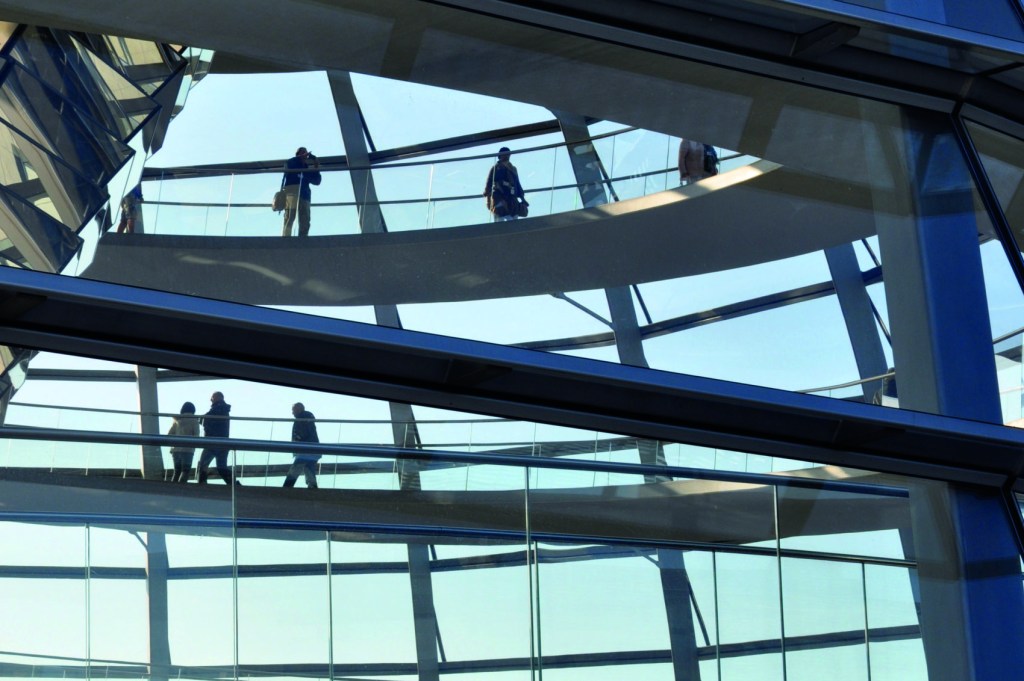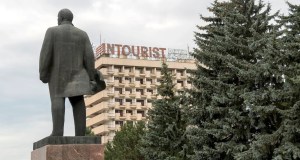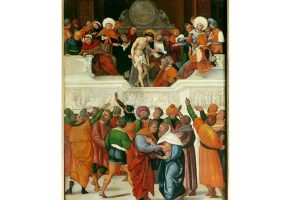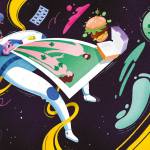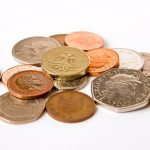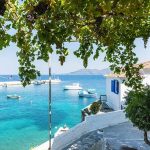Each time I return to Berlin, the wonderful, awful city where I spent the best days of my misspent youth, I pay a sentimental visit to Grolmanstrasse, where my German grandparents used to live. There isn’t much left to look at. Their apartment block was destroyed in 1945 in the Battle of Berlin. The site where it stood is now occupied by a children’s playground. For me, that empty space seems to symbolize the way Berlin has changed — mainly for the better, but at enormous human cost. So much has vanished — not just the buildings, but also the people who inhabited them. For my children’s generation, Berlin is a party town. For me, it’s a city full of ghosts.
It is these ghosts that keep bringing me back to Germany’s battered, bombastic capital. They’re what sets this place apart from any other city I know. No other city has suffered so much; no other city has caused such suffering. Every boulevard bears witness to Berlin’s triumphs and atrocities. You soon learn to read the clues. The hotel where you spent a restless night is a souvenir of the Second Reich, the modernist townhouse beside it is a remnant of the Weimar Republic, the office block next door is National Socialist, the tower block beyond is Stalinist and the sleek new skyscraper that looms over them isa symbol of the reunited Bundesrepublik. It’s more like archaeology than architecture: from Bismarck to Merkel, capitalism to communism and back again, the past stripped bare.
I first came to Berlin in 1991, a few months after reunification. The Berlin Wall had been down a year, but it still seemed like two separate cities. West Berlin was brash and glitzy; East Berlin was grand and funereal. Thirty years later, the two sides of the city have traded places. East Berlin is new and shiny; West Berlin is sedate and sleepy. East Berlin feels futuristic; West Berlin is a quaint relic of the Cold War. Yet Berlin has always been two cities, as Christopher Isherwood observed:
‘…the cluster of expensive hotels, bars, cinemas and shops round the Memorial Church, a sparkling nucleus of light, like a sham diamond, in the shabby twilight of the town; and the self-conscious civic center of buildings round the Unter den Linden.’
Today self-conscious sightseers swarm around Unter den Linden, East Berlin’s main boulevard, leaving the twilit bars of West Berlin to the locals. I wonder what Isherwood would have made of this strange turn around. If my morbid obsession with Berlin were mine alone, this story would be of finite interest, yet I’m merely one of many outsiders who can’t get enough of the place. But why?
After all, it’s hardly a typical tourist destination. Berlin is littered with construction sites and covered in graffiti; no one in his right mind would call it beautiful. Indeed, large swaths of it are spectacularly ugly, a sociologist’s paradise of concrete high-rise. The city is strewn with bomb sites, barely a single street remains intact and the older buildings are scarred with shrapnel. The renaissance of the last 30 years has been remarkable, but no amount of reconstruction can conceal the fact that this was once a battlefield. Thirty years since the Soviets departed, it still feels like a place emerging from a long and savage siege.
And yet the incomers keep on coming — some for a long weekend, some forever. What are they all looking for? Sure, there’s loads to see and do — shows and nightclubs, museums and galleries — but above all it’s the Berliner Luft (the ‘Berlin air’) that lures me and millions like me here: the sense that anything is possible. It’s a place you come to fall in love, or form a band, or write a novel. You probably won’t do any of those things, you’ll probably end up broke and disappointed, but if it’s ever going to happen you feel it might just happen here.
For anyone contemplating a trip to Berlin, there’s a wealth of literature to whet your appetite: Vladimir Nabokov, Joseph Roth, John Le Carré, Stefan Zweig. The city has also attracted numerous historians: Antony Beevor, Giles MacDonogh, Alexandra Richie, Neil MacGregor. It’s easy to see why it’s inspired so many writers. From hubris to nemesis to redemption, few subjects offer the writer such a dramatic storyline. The latest moth to the flame is Barney White-Spunner. ‘For me Berlin was a formative experience,’ he reveals. ‘It was a city I first knew in the 1970s, long before the Wall came down, and it has fascinated me ever since. I still get that same sense of excitement, dread even, when I arrive now as I did when I was traveling through the GDR [East Germany] and across the Wall 40 years ago.’
White-Spunner’s fascination with Berlin is apparent in every chapter of Berlin: The Story of a City. Astute and informative, his compact history covers the major developments of each era in clear, concise prose. I just wish he’d given himself a bigger role. Only once does he permit himself some fleeting personal reminiscence about his time as a British officer, stationed in West Germany during the Cold War.
White-Spunner begins his tale in 1237, which is generally regarded as the year Berlin was founded. In fact, as the author confirms, its history stretches far further back: its Jewish community, which has always been central to the city’s story, was already established by the year 1000. Indeed, Berlin’s Jewish roots are older than its Christian ones. Berlin was founded by a Slavic tribe called the Wends sometime during the Dark Ages. The Wends were pagans, and the first church wasn’t built in Berlin until 1232, 900 years after the Emperor Constantine had brought Christianity to western Germany.
The Christianization of Berlin was part of a crusade of colonial conquest by Teutonic Knights from western Europe, sanctioned by Pope Eugene III and his successors. The Pope granted them ownership of any pagan lands they converted, usually at sword point, and so the Wends were duly routed in the name of Jesus Christ. Berlin became a Teutonic settlement and German became the lingua franca, though the Wendish origins of Berlin’s surrounding villages survive in the Slavic names of its modern suburbs. Berlin has been German for 800 years, but for west Germans, it still seems a world elsewhere:
‘A lot of Germans thought Berlin was associated with first Prussian and then Nazi militarism. These were people who saw the border between the GDR [East Germany] and the FDR [West Germany] as more than just a communist-designed plot to divide Europe. For them it was the border between two Germanies, between the flat, sandy plains of Mecklenburg and the western-looking areas along the Rhine, areas the more historically minded argued had been colonized by the Romans and looked towards Europe while Berlin looked out east towards Russia and the steppes.’
Throughout the Middle Ages, Berlin remained an obscure backwater. By 1500, when London already had 75,000 inhabitants and Paris 200,000, its population was just 8,000. It was even dwarfed by its Germanic neighbors: Danzig and Magdeburg both boasted 30,000 souls. It was scarcely any bigger by the start of the 17th century — and then the Thirty Years War almost wiped it off the map. Germany became a battleground and Berlin was occupied by the Swedish army, who stripped the city bare. When the Swedes finally departed after years of rape and pillage, only a few hundred houses were left standing and the population had shrunk to a few thousand.
Berlin’s subsequent resurrection is one of the marvels of European history, rivaled only by its revival after 1945. The turning point came in 1670, when the Habsburg Emperor Leopold I expelled the Jews from Vienna. Such pogroms were a frequent occurrence in any European city where Jewish people lived and prospered. Berlin was no exception —the city had expelled its Jews in 1510 — but desperate times called for desperate remedies. Mindful of the need to rebuild his nascent capital, the Duke of Prussia, Friedrich Wilhelm, invited Vienna’s 50 richest Jewish families to relocate to Berlin. In 1685, when Louis XIV, the Sun King, expelled France’s Protestants (Huguenots), Friedrich Wilhelm repeated the invitation. This time, thousands came. Jews and Huguenots became key drivers in Berlin’s revival. You can still find French and Yiddish phrases in the local dialect, and French and Yiddish flavors in the local cuisine. Within a single generation, the population of the city tripled. Berlin’s rapid ascent (and Vienna’s gradual descent) had begun.
Berlin came of age under Frederick the Great, who ruled Prussia from 1740 to 1786. His military prowess made Berlin the capital of a major European power. Prussia subsequently emerged victorious from the Napoleonic Wars, and under Bismarck’s shrewd leadership it became the most powerful nation on the Continent. Berlin became the capital of an empire that stretched across Europe, from Lithuania to Lorraine.
The 20th century should have been Berlin’s century. Instead, it was a catastrophe: bled white by World War One, bankrupted in the Twenties, tyrannized in the Thirties, destroyed in World War Two. Yet Berlin has always come alive in times of chaos and uncertainty, as it did during the Weimar Republic and after the fall of the Berlin Wall. ‘In the 1920s and in the last few decades Berlin has challenged the rest of Europe with the diversity of its free thinking,’ says White-Spunner. But free thinking about what, exactly? No one, including White-Spunner, seems entirely sure.
Today the Berlin Wall (actually two walls, divided by a so-called ‘death strip’) has become a garden. Locals walk their dogs in this former no man’s land. From the roof of the Reichstag, which is crowned by Norman Foster’s dazzling new cupola, the rejuvenated city center lies spread out below you. Compared to the view I first saw 30 years ago, it’s almost unrecognizable. The city was ravaged and divided for 40 years, but today you can barely see the join. Old monuments have been restored, historic landmarks have been rebuilt from scratch — the Berliner Schloss, the Adlon Hotel. It’s an incredible feat of restoration, yet it feels as if there’s something missing. That something is Berlin’s Jewish community, which Bernard Levin called ‘the salt in the stew’. Since reunification, Jews have been returning; many of the families are from ex-Soviet states, and the younger bohemians from Israel. The Jewish population is now about 15,000: less than 10 percent of what it was in 1933.
Ten years ago, I traveled to Berlin with a group of British Jews. None of them had been to Berlin before. Most of them had never been to Germany. Among the group was Rabbi Ephraim Mirvis, now Chief Rabbi of the United Hebrew Congregations of the Commonwealth. It was his first visit to the Bundesrepublik.
‘I didn’t expect to enjoy it and I haven’t enjoyed it,’ he told me. ‘I found it very enlightening, in some respects even inspiring. But it’s not easy for a Jewish person to walk down these streets.’ I understood what he meant. On almost every street you’ll see Stolpersteine (stumbling stones) embedded in the sidewalk, brass plaques commemorating the Jews who lived here. Each plaque bears a name, a date and a final destination. Each one marks a life cut short.
I’ve lost count of all the times I’ve come here, looking for a story. Berlin is full of stories. If you can’t make it as a reporter here, you might as well give up. From the Third Reich to the Mauerfall (as Berliners call the fall of the Berlin Wall), this city has more plot twists than a bad thriller. Yet whichever story you choose to tell, you always end up back at the Shoah. The most prominent reminder is Peter Eisenman’s Memorial to the Murdered Jews of Europe, a vast maze of monoliths beside the Brandenburg Gate, but there are loads of smaller memorials too. For me, the most moving is the one on Bebelplatz, opposite Humboldt University, where the Nazis burned the books of some of Germany’s greatest writers, including Heinrich Heine, whose prophetic words now mark this spot: ‘Where they burn books, in the end they will burn people,’ he wrote, in 1821. The memorial depicts an empty library.
Berlin is full of Holocaust memorials, but Berliners don’t tend to talk about them. For them, the last century is like a bad dream they’d far rather forget. Yet whatever brings you here — nightlife, street life, high culture — the past keeps pulling you back. In the subway station at Grunewald, one of Berlin’s chicer suburbs, is the secluded platform where the trains departed for the death camps. The list of departures and passengers stretches way down the tracks.
One of those trains was bound for a concentration camp in Minsk, and one of the passengers on that train was a young Jewish Berliner called Manfred Alexander. Manfred escaped from Minsk and made it back to Berlin, where my grandfather hid him in his apartment and arranged his escape to Switzerland. My grandfather, Werner von Biel, was a feckless toff who’d come to Berlin to escape his reactionary Prussian family. In that respect, he was like a lot of Germans who end up here. In Berlin, Werner met an entirely different type of person from the aristocratic Junkers he’d grown up with: artists, writers, homosexuals. It was here that he met Manfred. Was Berlin the ruin of him or the making of him? A bit of both, I suppose. He went to prison for insurance fraud. He also saved Manfred’s life.
I never met my grandfather (he died when I was a child), but I did meet Manfred. After the war he immigrated to America and ended up working as a caretaker in Queens. I went to see him there several times and wrote an article about him. We became good friends. As a result of that article my grandfather was posthumously awarded the Righteous Among the Nations medal by Yad Vashem, Israel’s Holocaust memorial center. Manfred and I went to the Israeli consulate in New York to collect it. He died a few months later. Last year, I went back to Charlottenburg, the leafy suburb where Manfred grew up. The apartment block he lived in and the school he went to are still there.
Berlin was never a Nazi stronghold. It had always been a ‘red’ city, dominated by the Social Democrats, which is why the Nazis planned to demolish it and replace it with a megalopolis called Germania. Hitler called it a city of ‘a thousand superficial impressions, of cheap neon advertising and sham politics’; Goebbels called it ‘a melting pot of everything that is evil — prostitution, bars, cinemas, Marxism, Judaism, strippers, dancing negroes and all the vile off shoots of so-called Modern Art’. Yet no special pleading can erase the truth that this was the capital of the Third Reich and the Holocaust. The Final Solution was finalized in a lovely lake-side villa at Wannsee, on the green edge of the city. Next door was the home of Max Liebermann, one of Germany’s finest painters. Liebermann, a German Jew, died of natural causes in 1935; his wife killed herself in 1943 on the eve of her transportation to Theresienstadt concentration camp. Today both villas are museums: the best and worst of Germany, side by side.
Growing up in England, a generation after World War Two, with a German father and an English mother (and an English last name, which gave me the perfect cover), I met a lot of English people who believed there was some fundamental flaw in the German character, something in the German psyche that made Germans uniquely cruel. I was upset to hear them say so, but I found it hard to refute them. After everything that had happened, it was a reasonable assumption. I sometimes wondered about it myself. Half a century later, I hear this argument a lot less often.The Bundesrepublik is a model democracy, a bastion of liberalism, and there’s no such thing as a typical German — least of all in Berlin, an immigrant city since the Middle Ages — but I still ponder the question from time to time. I’m proud to be a German citizen, yet alongside my immense admiration for modern Germany there remains a lingering sense of doubt and an enduring sense of shame. I guess that’s how it should be. A lifetime since it happened, the Holocaust remains unfathomable (and the more I see of Germany, the more unfathomable it becomes), but it’s impossible to forget this was a German genocide, enabled and enacted in Berlin. Anywhere you go, the Shoah is center stage. The best thing I can say about Berlin is that it admits all this quite openly, with no omissions or excuses.
When the Berlin Wall came tumbling down in the fall of 1989, many feared Berlin might become the capital of a Fourth Reich. They needn’t have worried. Berlin has become a cultural capital instead. ‘Poor but sexy’, as its charismatic and gay ex-mayor, Klaus Wowereit, once called it, it’s dynamic and invigorating. It’s also unruly and shambolic. It’s unlike any other city in Germany, or Europe for that matter. Like New York, it feels like a place apart, a city estranged from its natural hinterland. Provincial Germans shudder at the prospect that their children might end up living here. White-Spunner calls modern Berlin ‘a diverse, open community, law-abiding but independent of authority’.That strikes me as a bit idealistic, but I know what he means.
Berlin has always been a magnet for beatniks and refuseniks. During the Cold War it was the only place in West Germany where you didn’t have to do national service, so punks and hippies came here to dodge the draft. When I arrived they were still around, teetering on the edge of middle age. For them, the Mauerfall was a glorious revolution: not just the collapse of East German communism, but a transformation of West German capitalism — or so they hoped. It didn’t quite work out that way. The West German parliament voted (narrowly) to return to Berlin, derelict warehouses were snapped up by sharp developers, the squatters were driven out and big business moved in. In the end, there was no third way, however much those punks and hippies might have yearned for it.
Berliners had to make a choice, between state socialism and the free market. Thankfully they chose the latter, and some sort of normality returned. Now a new generation of layabouts is coming to Berlin and finding it just as thrilling. It’s not as anarchic as it used to be, but it’s a lot cheaper than most European capitals. If you don’t have much money and you want to do your own thing, this is still the place to come. From the Berlin Airlift to the Peaceful Revolution, it’s been a city where people defied the odds and made things happen. Sure, Berlin has its dark side. But, as White-Spunner says, it’s not all doom and gloom:
‘There is a particular frisson about Berlin, a combination of excitement, nervousness and the unexpected. Through all its life it has been a city of tensions. Its position — on the frontier of Europe, on the Mark [borderland] where Christianity met paganism, where the Huns met the Slavs, where Europe met Russia and where fertile land met the sands, swamps and forests of Pomerania and Prussia — gives it a geographical tension. It was also long a city of religious tension, between a largely Lutheran people and a Calvinist government, and later becoming pretty irreligious altogether.’
I’ve spent more time here than in any other city apart from London, but like London it’s a young man’s town and now I’m too old for it. I’ll always love it, in spite of all its faults — the noise, the grime, the aggravation — but it belongs to a new generation now, for whom the Cold War is the stuff of history books, something their parents like to talk about. Berlin belongs to its newcomers, those twenty somethings fresh off the night train with the vague promise of a couch to sleep on. These are the people that give Berlin its nervous energy, not old-timers like me.
The last time I came here was during that listless interregnum between Britain’s first and second lockdowns. The bars and cafes were full, but the atmosphere was strained. It reminded me of the wartime joke Berliners used to tell, typical of their sardonic sense of humor: ‘Enjoy the war while it lasts — the peace will be worse.’ I’d come back to write about the 30th anniversary of reunification, but I soon realized the younger generation weren’t really interested. Berlin is not a nostalgic place. The city had moved on.
By the time their home was bombed, my grandparents were both long gone. My grandfather had been drafted into the Wehrmacht. My grandmother had fled to Hamburg with my infant father to escape the rapacious Red Army. There she met a British soldier and decided to try her luck in Britain. My grandfather ended up in a British prisoner-of-war camp (a lucky escape) and finally made it back to Munich. He never saw her again. Today children play on swings and slides and climbing frames where their apartment block once stood, where Manfred Alexander hid and rested up, where my father was conceived. Their shrieks and shouts echo around the windswept street. What does the future hold in store for them? Despite all the troubles in the world, I remain optimistic. This Faustian metropolis has already weathered the worst of times. For the next generation of Berliners, the only way is up.
Barney White-Spunner’s Berlin: The Story of a City is published by Pegasus. This article was originally published in The Spectator’s May 2021 World edition.
